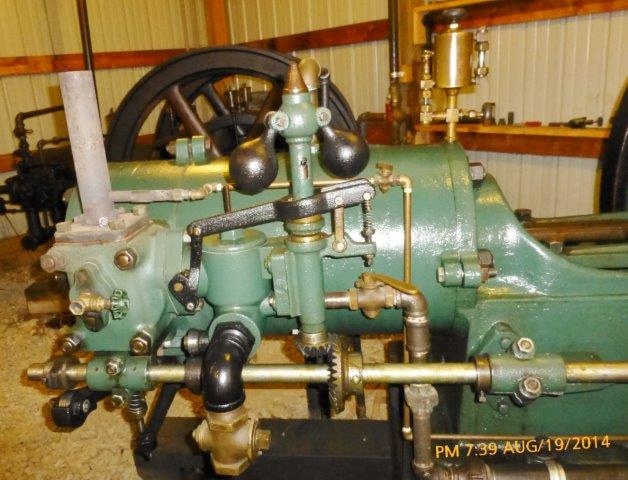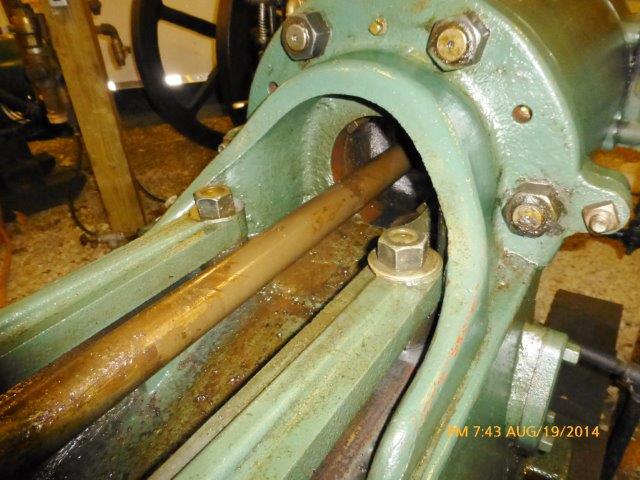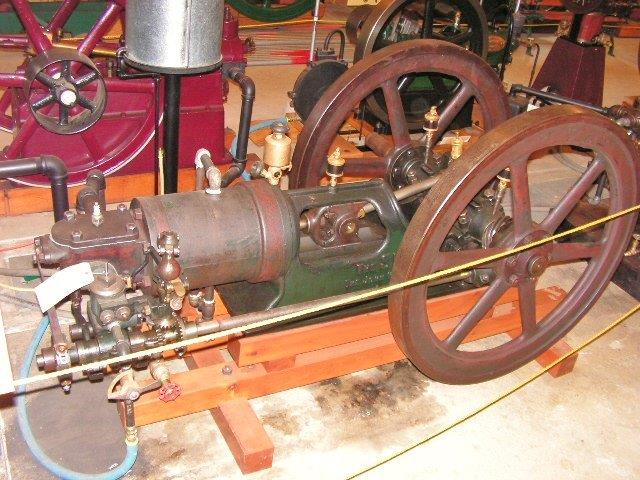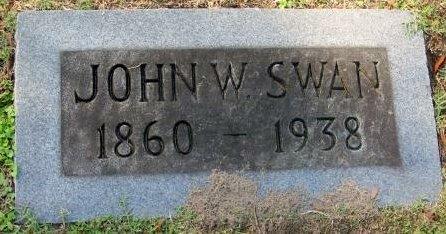|

October 2014
The Swan Story
By
Paul Harvey
While searching for a
topic for my October Flywheel
article, my mind drifted to two of the museum's most unique engines, the
Swan and the
Lima. Both
were manufactured in
Lima,
Ohio, and
share many interesting features; the connection has always been a
mystery to me. Now I have a topic
and a quest to discover information!
I plunged into the depths of the internet and found bits and
pieces here and there which made enough to complete the story.
With the newly gained knowledge, this will now be a two part
article with Swan discussed in October and
Lima in
November. I hope the reader finds
this as fascinating to read as I did to write.
Nelson Swan was a
Swedish immigrant who married Esther Sander from
Pennsylvania.
They moved to
Shawnee in rural Allen County, Ohio.
Lima is the main town in
Allen
County, and
here our story unfolds. John W.
Swan, born in 1860, was the
second child of six in the family and grew up on a farm.
The 1870 U.S. Census
lists John as "works on a farm."
He was only ten years old then.
He married
Florence in 1894, and there is no record of any children
to the couple. At age 40, in
1900, we find him living in
Lima and the manager of a machine company.
The 1903 Lima City
Directory notes that he was general manager of the John W. Swan
Company which was located at the South West Corner, C&E RR and
Greenlawn Avenue. His
residence was
218 Nye Avenue,
Lima,
Ohio. This was
the time that he built the engines that bear his name.
In 1902, he patented a
gas engine and a starting device for the engine and assigned the patents
to the John W. Swan Co. J.O.
Hover was president and Swan was general manager.
The company changed its name to the Lima Gas Engine Company in
1905, and Swan was no longer associated with it. His tenure as a gas engine designer and manufacturer only lasted
about three or four years. He is also
credited with two oil well pump jack patents; one in 1900 and one in
1905. One reference mentions that
Swan, after leaving the gas engines, joined with a Mr. Owen and a Mr.
Palmer to form the Lima Motor Car Company.
For a short time, the firm sold Peerless and Velie automobiles.
However, Swan's time in
Lima was soon over as he decided to follow the sun
and move west.
The 1910
U.S. Census lists John and
Florence living in
San Diego,
California,
where he was employed as the manager of an automotive store.
He then moved to
Los Angeles where he became interested in carburetor design.
He patented his first carburetor there, and his next patent was from
San Francisco. This one
was designed "especially for Fords."
His last four carburetor and manifold patents were obtained
in the 1920s when he was living in
Connecticut.
The Foundry,
January 1913, states that the
Swan Carburetor Company was incorporated in
San Francisco and specialized in exhaust and intake manifolds,
as well as carburetors. Swan was
not mentioned as an officer. The
April 1919 issue of Engineering
states that the firm was located at
540 Van Ness Avenue,
San Francisco,
California. A 1927 listing shows that it was
located in
Cleveland,
Ohio, at
that time. There is no further
mention of the Swan Carburetor Company.
The 1920
U.S. Census shows that
the Swans were living in
Fairfield,
Connecticut, and
John was employed as an engineer for the Yale and Towne Lock Shop.
His interest in carburetors and manifolds continued and his last
four patents were obtained during this decade.
Ten varied patents are credited to this prolific designer and
engineer. Then another move and
this time to the south. The 1930
U.S. Census indicates that John
and
Florence were living in
Sarasota,
Florida.
Probably at a hotel, they were listed as "lodgers" along with 20
other names. Now 70 years old,
his occupation was listed as "engineer."
In 1936, the Sarasota City
Directory states they lived at
398 Gulf Stream Ave., Apt 4,
Sarasota,
Florida. John
passed away in 1938 and was buried in
Bradenton,
Florida.
So ended the life but not the legacy of this most interesting
individual.
Photo 1
is John Swan's first gas engine patent,
750,318,
applied for in 1902 and granted in 1904.
It is his "starting device" which is a compression release with a
novel return. By turning a knob
on the exhaust cam cluster, a finger or cam is advanced into play
opposite the exhaust cam. This
additional cam "bumps" the exhaust valve open on the compression stroke
to relieve some pressure, hence making starting easier.
As the engine picks up speed, the knob is held by hand, and the
starting cam recedes out of play by a screw thread on the exhaust cam.
The museum's Swan engine does not have this feature but the
Lima does. His
second gas engine patent,
Photo 2, number
771,028, shows a very unique device for removing
all the exhaust gases from the cylinder.
The exhaust from the valve communicates with a space behind the
piston and discharges into a chamber in the bed plate under the cross
head. In his patent, the rear of
the cylinder is closed with a stuffing box, and as the piston moves
forward, a vacuum is created which helps clear the cylinder of burnt
gases. Final exhaust is from the
bed plate. It does not appear
that this would have been very successful, but the museum's Swan engine
does have vestiges of the device evident.
Swan's second
carburetor patent, number
1,260,594, was applied for in
1904 and granted in 1918, when he was living in
San Francisco. It
is shown in
Photo 3. He claimed
improved float and needle valve design.
Horseless Age,
July 28, 1915, shows a photo of this carburetor, noted in
Photo 4.
This is the carburetor that he built for Fords, claiming
it was superior to the original equipment.
Some of his carburetors still exist.
John Wilcox and I made
a snowy venture into the oil fields of
western
Ohio and eastern
Indiana in the winter of 1975 in search of goodies.
He mentioned a Swan engine; I had not even heard of one.
So we headed for
Pennville,
Indiana, and
a certain farm where he remembered one. The farmer greeted us and
told us to go take a look.
Evening was approaching as we trudged through two foot snow
drifts way out into the cornfield. Despite
the cold wind, we found the Swan;
the power house had burnt down around the engine and it was badly
weathered. Many small parts were
missing. Refer to
Photo 5.
But it was a Swan and I made an agreement with the farmer
to be back the next summer to get it.
Next summer, my wife,
Marilyn, and I made the journey to retrieve the engine.
Photo 6 shows Marilyn
and I starting the disassembly of the outboard bearing and clutch.
Unfortunately, due to weight, we were forced to leave these items
behind.
Photo 7 shows the
engine ready to pull up the planks onto the trailer with the hand
come-along. This is the way I
moved engines in the early days! Photo 8 depicts a job well
done. As I make one last check of
the load and trailer,
Photo 9, I wondered a bit about the Scout and the big load.
But the trip home was safe and uneventful and now the Swan is in
Coolspring.
The Swan sat outside
at home for many years, just being a good conversation piece, before
being restored and placed into operation.
Presently, it resides in the
Expo
Building and is a great runner. See
Photo 10.
It is 25 horsepower and throttle governed.
Ignition is hot tube and both the intake and exhaust valves are
power operated. The governor
controls a butterfly valve in the mixer. The cylinder detail is seen in
Photo 11.
Part of Swan's patent is evident in
Photo 12.
Note the small opening in the frame for the piston rod
which is where the stuffing box would have been located.
The area under the crosshead is the enclosed expansion chamber
with the opening to the right for the exhaust.
Photo 13 is a detail
of the head and valve chests. It
sports the common western
Ohio "T"
head design, having the intake chest to the right and the exhaust to the
left. These valves are vertical;
the
Lima uses horizontal valves. The John W. Swan Co.
name is clearly evident with the serial number of 151.
We date this engine circa 1902.
Photo 14
shows a 5 horsepower Swan engine, the only other
one in existence to my knowledge, as displayed in the
Susong
Building years ago. It has some
significant differences from the 25 horsepower engine.
Note the bored, over and under, crosshead and the in-line valve
placement. Although the valves
are vertical, this is a departure from the "T" head design shown in the
patent. The Swan name is cast into the side of the frame and ignition is
by timer and spark plug.
Otherwise, it retains many of the Swan features.
Shown in
Photo 15 is a
cylinder and head detail which shows this engine has the patented Swan
compression release.
And so the Swan story
concludes with
Photo 16. Next month
the article will continue with the
Lima story.
The museum's 2014 season
will soon end with our big Fall Show and Swap Meet on October 16, 17,
and 18. Please try to
attend. Many of our engines will be running, and we will also have
guest exhibitors, a flea market, and plenty of good food. Special off season tours can be arranged by contacting the
museum.
Please see our website at
www.coolspringpowermuseum.org or call 814-849-6883. See you
then!
|
















